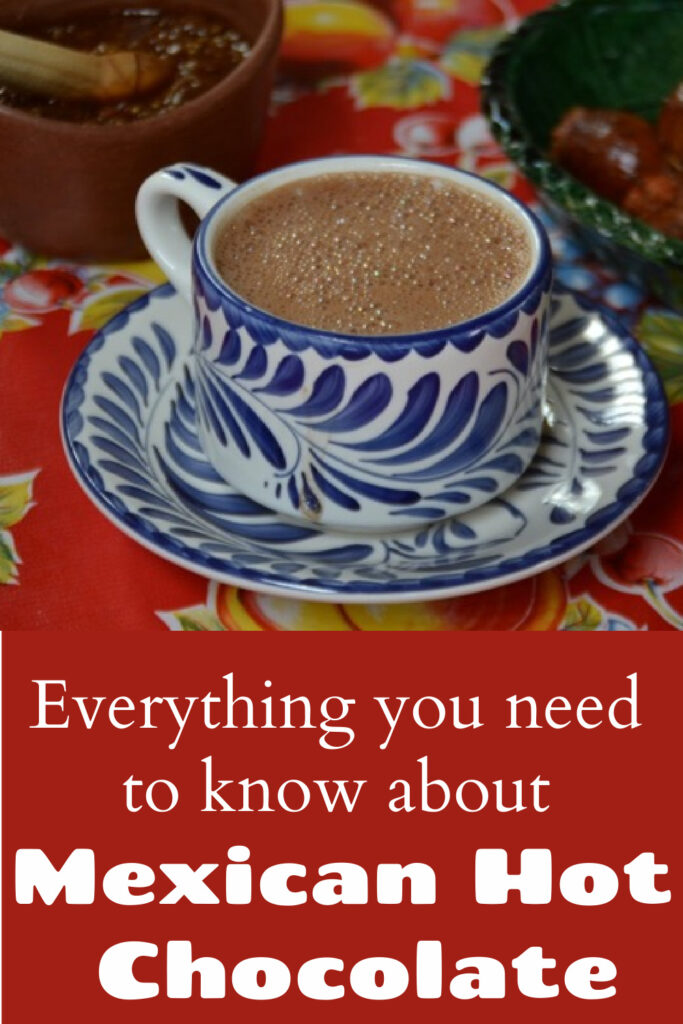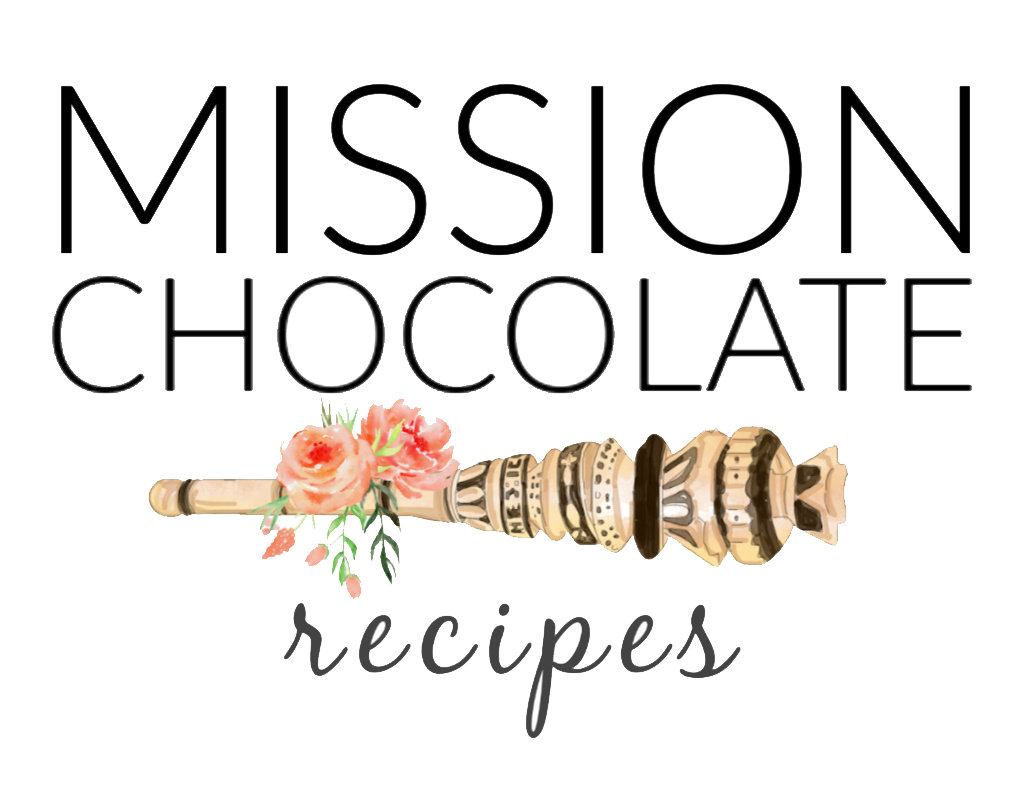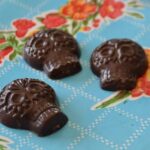Everything you need to know about Mexican Hot Chocolate
A Mexican hot chocolate is a hot drink prepared in Mexico or in the style of how Mexicans drink chocolate, which means grinding cacao, adding hot water or milk, sugar, and cinnamon. In Mexico, they generally just call it a chocolate but given the amount of Mexican immigrants in the USA, the name Mexican hot chocolate is what English speaking countries call it. The name is very important to distinguish it from the more common American hot cocoa drink. Which is something very distant from Mexican hot chocolate. Mexican hot chocolate is a cacao based drink that is ubiquitous in Mexico but also popular throughout Central America all the way to down to Colombia
Even though the recipes could be similar, no other country in Latin America, or the world, has the same amount of obsession for drinking chocolate as the Mexicans. The Aztec, Maya, and all indigenous communities of these areas, enjoyed hot chocolate for thousands of years before it was discovered by Europeans. The origin of the word chocolate comes from xocolatl (bitter water), from the ancient Aztec language, Náhuatl. Another important word in this region is xocola’j which means “to drink chocolate together”. Mexican hot chocolate has a history of over 4,000 years, whilst chocolate bars, or eating chocolate, has a short history of only about 200 years!
Traveling to the different regions of Mexico, like Veracruz, Tabasco, Oaxaca, and Chiapas, you can discover chocolate drinks that you have never heard of before. There are hundreds of recipes that are still prepared daily and vary from region to region and family to family.

Original recipes dating back thousands of years only contained cacao, water, and sometimes corn. But when people today use the description of Mexican Hot Chocolate, they are usually referring to the most popular current versions which are made with cacao, sugar, ceylon cinnamon, and milk. It can be enjoyed every day for breakfast or as a snack – this is common for children in Mexico and Central America. But it is highly consumed around indigenous and religious holidays like Christmas, Three Kings Day, and Day of the Dead. Then and now, cacao-based drinks are a must for any celebration. The most prized drink being chocolate-atole, native to Oaxaca, a fermented cacao drink that takes 5-6 months to prepare and is valued for its amazing thick froth.
The largest consumers of any cacao based drinks are Mexico, Central America, Ecuador, Colombia, Peru, and the Philippines. Although most Americans and Europeans recognize it as Mexican Hot Chocolate, it goes by different names in different countries. These are some of the names used: chocolate, chocolate de mesa, tableta, tablea, tablilla, or pastilla. All of this would be similar to what is kwown as Mexican Hot Chocolate. Soon after the Spanish colonized Mexico, and learned to make chocolate drinks, they colonized the Philippines and took the cacao drinking culture there. Both the cacao tree and hot chocolate recipes were taken to the Philippines by the Spanish. There you can find it under the name tablea or tableya.
Hot chocolate made from cacao is not commonly consumed in other Latin American countries like Brazil, Argentina, Chile, Uruguay, or Paraguay. Their version is made with chocolate chips or chocolate bars instead of cacao. Which might be confusing to you. Mexico and Central America make their chocolate drinks with ground cacao nibs … they can be ground on a stone then added to the liquid. Whereas the other countries I mention, take chocolate chips or a chocolate bar and melt it to make their drink. It is two different things. Read more below.
Brazil, Argentina, Uruguay, Chile and Paraguay showed no strong interest in cacao because they were already consuming other stimulants, like guaraná and maté, that were easier to grow and harvest and they did not see the allure of going through the long process necessary to turn cacao into chocolate. They also did not use the metate, or stone tool, that was widely used in Mesoamerica to cook. Therefore, they had no way of processing the cacao bean into a paste. It was not until the surge of Portuguese and Italian immigrants into Brazil, Argentina, and the aforementioned countries, that drinking chocolate began to emerge, but only in the European style. A Brazilian would not recognize a Mexican Hot Chocolate as a hot chocolate drink. And a person from Oaxaca, Mexico, would not recognized a Brazilian hot chocolate as a chocolate drink.
But let’s get back to Mexican Hot Chocolate. In Colombia they drink the same drink, but they don’t call it Mexican hot chocolate. Same thing in Panama, Guatemala, Belize, etc. They have their own names like bebida de cacao or bebida de chocolate, but the recipes are the same.
The chocolate industry, or us professionals of chocolate, refer to the mix used for making this drink as unrefined chocolate, or cocoa mass, or cocoa liquor. There is no one term that can describe this type of product. For simplicity, I refer to the ground cacao as unrefined chocolate. Below is an image I took in Guatemala of freshly ground cacao that we stored in banana leaves and let harden. This unrefined chocolate will harden and be stored until it is time to make a cacao drink.
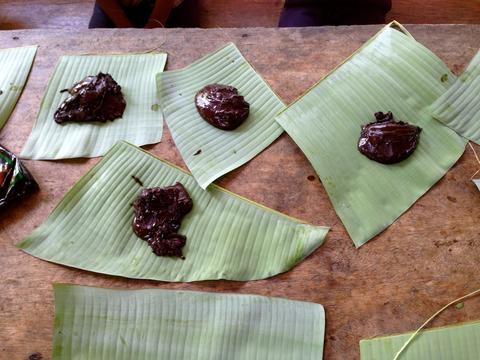

Unrefined chocolate is made by grinding cacao on a metate, molino, or some sort of grinder. It is a pretty basic process. Get cacao beans, roast, crack, remove husks, and grind. This unrefined chocolate could be further refined for a few hours or days and it will become a creamy, smooth chocolate bar. At this point, it would be considered a refined chocolate.
I can take unrefined chocolate and sugar and transform that into a smooth chocolate bar, but I cannot take a smooth chocolate bar and transform that back into unrefined chocolate. The main characteristic of an unrefined chocolate is that it has very little processing and the flavor remains very strong. Recipes that claim to be for traditional Mexican hot chocolate drinks, but contain chocolate chips, chocolate bars, or cocoa powder in the ingredients, are not correct. I am not saying it will not be tasty, I am saying it will not have that special authentic unrefined cacao flavor.
Chocolate chips and bars have been ground and refined a long time to give it that smooth texture and will have lost a lot of flavor by the time they are ready to enjoy. And they might have the addition of vanilla, cocoa butter, and soy lecithin.
And then there are recipes that call for cocoa powder which is made by pressing the cacao nibs (cacao beans without the husk) and removing the cocoa butter, thus using only cocoa powder for the Mexican chocolate drink will not result in an authentic flavor. The ancient recipes are made with ground cacao that has not been refined for longer than a few minutes. Remember, this used to be done by hand, no machines. Actually, this style of unrefined chocolate is still largely hand-processed. This is why the texture of a true Mexican chocolate will always be gritty and grainy.
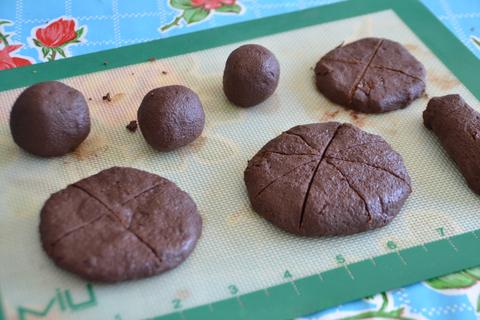
If you want to experience the most authentic Mexican hot chocolate or cacao drink, the one that is thousands of years old, you should mix ground cacao with water and serve it lukewarm. You might add ground corn, achiote, or vanilla. What we now consider Mexican hot chocolate is a more modern recipe that became popular when the Spanish arrived in Mexico, bringing with them milk, sugar, cinnamon, and the desire to consume it hot. It was not until the late 1500s, 3500 years after the drink was discovered, that the recipe was altered. The Spanish began to grind cacao with sugar, cinnamon, nuts, anise, or sesame seeds, and remove the corn and other native ingredients.
Currently, many indigenous communities in Mexico, Central America, Peru, Colombia, and Venezuela continue to drink it with only water and perhaps ground corn. There are hundreds of recipes for cacao drinks in the Americas. To see the top 5 cacao drinks of Mexico, visit my post here.
Image below of a cacao drink in Belize made with ground cacao and water in traditional drinking cup called xicara, jícara, or calabash.
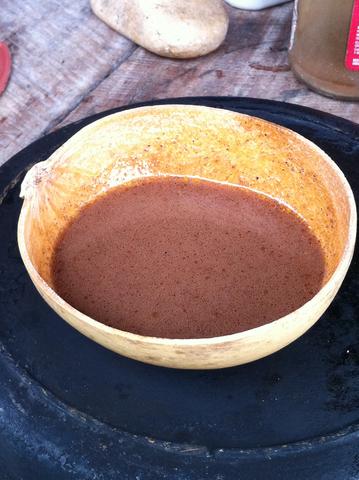
The cacao. Cacao was first cultivated and consumed in Mexico. But most experts agree that the actual tree is native to the Amazon. There is debate on whether it was the Brazilian Amazon, Peruvian Amazon, Venezuelan Amazon or Colombian Amazon. If you are from any of these countries you are convinced it came from your country.
You can purchase two types of cacao: fermented or unfermented. The world’s finest chocolate bars are made with fermented cacao. They cut the cacao fruit, remove the seeds, put them in a wooden box or pile to ferment for 4-8 days. The cacao is then dried in the sun for 6 to 15 days. Fermentation is one key step to developing complex chocolatey flavors in high quality chocolate. You can get fermented cacao at MeridianCacao.com or chocolatealchemy.com.
Most chocolate in Mexico that is meant for drinking, is made with unfermented cacao. This is also known as washed cacao or cacao lavado. Farmers cut the fruit, remove the seeds, wash them with water and let them dry in the sun for 6 to 15 days. You can find unfermented cacao at Latin grocery stores in the USA. It might not say unfermented cacao or cacao lavado (washed), but you can tell by looking at the surface. This is a stand at a Mexican market in Oaxaca – on the left is washed cacao and on the right is fermented cacao. Washed cacao is usually more expensive because it requires more work.
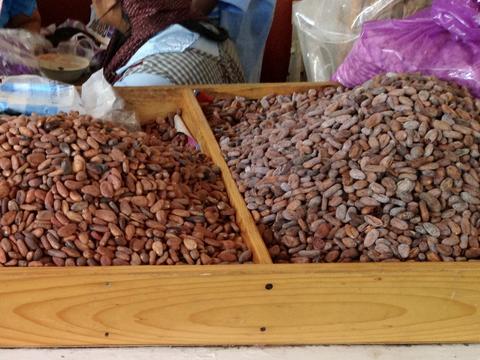
Tools required to make Mexican hot chocolate
Metate. Before the Spanish arrived in the Americas, the quintessential kitchen tool was the metate. The metate is used in rural regions to prepare meals, including the mix for cacao drinks. The word metate comes from metlatl, a word from the Aztec language, Náhuatl. This rock slab still remains a great tool for making the mix for cacao drinks. Many women still use this to prepare daily meals. If you want to know much more about metates visit my post about “How to use a metate”. I was lucky enough to inherit my mother’s metate, given to her in 1957 and my grandmother’s metate, given to her in 1930. Some metates have three legs and others have none. To learn too much about metates … I have a 1 hour course on UDEMY.COM on how to season and use your metate.
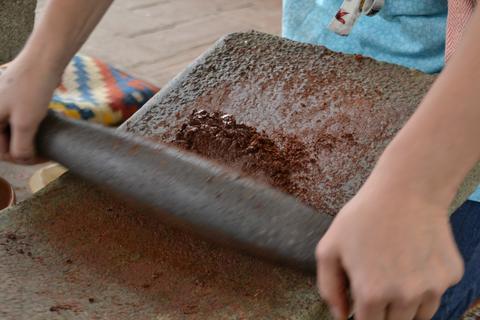
The process of making the cacao mix on a metate is simple. After you have roasted, cracked, and separated the nibs from the husks, you place the cacao on the rock and begin to grind it. It helps if you are in a warm area, otherwise you can place a candle or hot ash under the metate to help warm it. Or you can place the metate in a hot oven, 100c for 15 minutes, to warm it before you begin to grind. The more warm your metate, the easier the cacao will grind. You can also warm the nibs before grinding. It takes 5-10 passes to create a very liquid cacao paste.
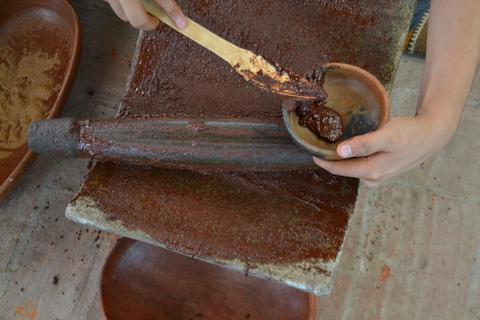
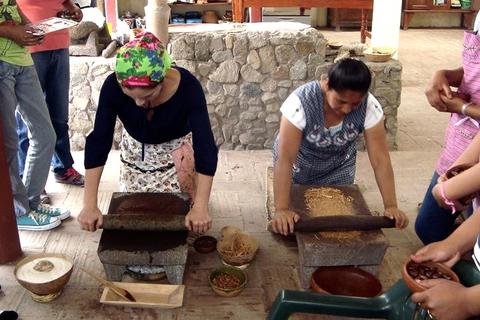
Molinillo. Molinillos are wooden whisks created for the single purpose of mixing and creating froth in cacao drinks. An ancient tool that is thought to create a foam that when consumed, will bring wisdom and power. The foam carries oxygen into the body. This tool is sometimes passed down from mother to daughter but it is usual for every woman to get her own new molinillo. In Mexico, Ecuador, Guatemala, and Peru they are made entirely from wood and in Colombia it is a combination of wood and metal. Most molinillos are made entirely from one piece of wood and are considered pieces of art. These are still handmade by small craftsmen throughout Latin America. In Náhuatl it is called a chicolli. You can buy one directly from a Zapotec community in Oaxaca here: Etsy store El Nahual.

Chocolatero. A chocolatero is a special vessel with the sole purpose of mixing or frothing the cacao drink. In Mexico it is usually orange clay or painted green, and in Colombia they have a famous design made from aluminum. The important design component is that the bottom should be wide enough to allow you to whisk and that it be tall enough to avoid spilling.
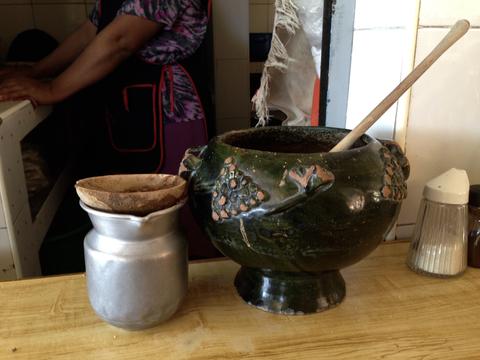
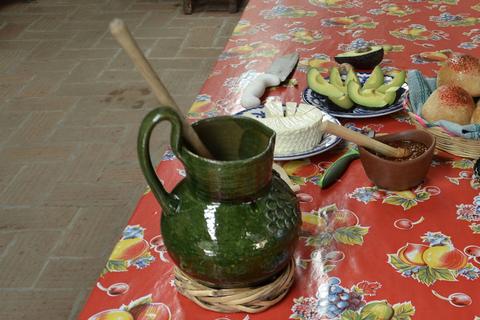
Molino. After the European arrival in the mid-1800s, a new tool began to appear: the molino, a mill. This tool facilitated grinding cacao (as well as corn, rice, spices, etc.) for the kitchen. Nowadays the molino has replaced the metate in modern homes for making cacao mixes and grinding corn. If you live in Oaxaca, Mexico, there are stores, also called molinos, that have electric molinos and will grind the food/cacao for you for a small fee.
Some molinos will sell cacao as well. In Oaxaca you can see many of these molino stores. You have the option to buy unfermented cacao, otherwise known as washed cacao, or fermented cacao. From here you choose peeled cacao (without the husk) or with the husk. Peeled is more expensive. Choose whether you want sugar, almonds, or cinnamon. They will completely customize your chocolate mix for you. A small hand cranked molino will cost about $30 and a motorized one will cost $200. Selling molinillos in Oaxaca outside the popular molino, Mayordomo.
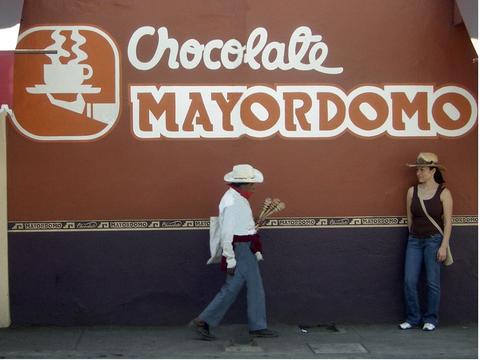
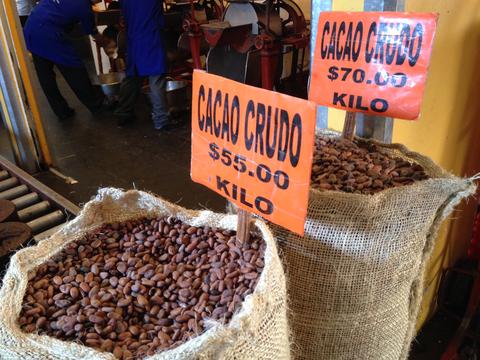
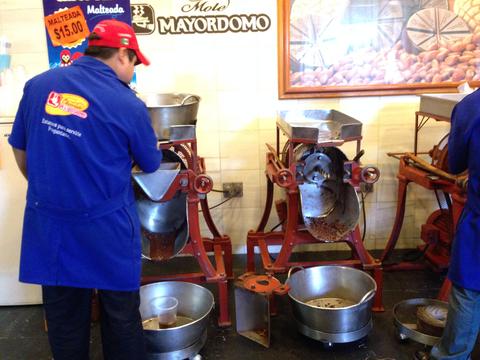
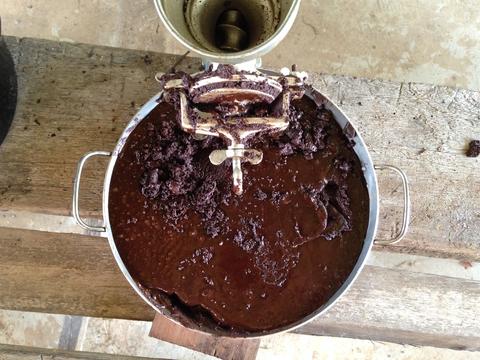
The metate, molinillo, chocolatero, and molino remain the single most important tools for making cacao mixes/pastes and for preparing chocolate drinks.
The Industry
Popular brands of mixes for cacao drinks are Abuelita and Ibarra. They are owned by large companies and contain more sugar than cacao, added vegetable oil, artificial flavors, cocoa powder, or soy lecithin. And they also contain the most low quality cacao available. The companies originally started with a high quality product but have plummeted in quality over the years. A good Mexican hot chocolate should only have cacao, sugar, and some natural flavors, like cinnamon, coffee, almond, etc.
The brands that are large and good quality: Casa Luker from Colombia, or Mayordomo and La Soledad from Mexico.
The big companies will use mostly African cacao because they are the cheapest in price. The fact that the brand uses the terms “Mexican hot chocolate” does not mean that it was made with Mexican cacao; it means it is a style of drinking chocolate. Even if you purchase the Mexican chocolate in Mexico from Mexicans, it might be cacao from Africa or another country. Mexico imports a lot of cacao beans from Africa and recently from Ecuador. If it does not indicate a source of cacao, a state or country, you can assume it is from Africa, which is true for any eating or drinking chocolate in the world.
Clarity on styles of drinking chocolate
Aztec or Mayan Chocolate: Ground cacao, cocoa powder, or chocolate with cinnamon, chili, and/or other spices. This is a recent style invented by many romantic American and European chocolatiers. Example: Lake Champlain Aztec Hot Chocolate or Nomadic Drinking Chocolate. They use the word Aztec to indicate that it has chili or spices. But it does not resemble anything the Aztecs drank nor anything currently consumed in the Americas. It is a new style of drinking chocolate – liking chili in your drink is completely personal. As an American-Mexican, I admit putting chili on everything, except my chocolate! Chile in chocolate is a romantic idea dreamt up by Westerners.
Spanish Chocolate: Ground cacao, cocoa powder, or chocolate usually thickened with rice, flour, cornstarch, or wheat. Meant to be thick enough to dip things in, like churros! You can find churrerias, or churro shops, all over Spain that serve churros to be dipped in chocolate. It is almost the consistency of a pudding. Example: Valor Chocolate a la taza.
French Chocolate, Sipping Chocolate, Drinking Chocolate: Made with cocoa powder, chocolate chips or bars, vanilla, milk, and/or heavy cream. Very thick and rich, literally feels like you are drinking a melted chocolate bar. Luxurious. Example: Ghirardelli Drinking Chocolate, Treehouse Organic Hot Chocolate.
Hot Chocolate or Hot Cocoa: Has origins in America or the United Kingdom, uses cocoa powder instead of cacao or chocolate. Can be made with milk or water, very weak and sweet. Usually comes with marshmallows and marketed towards children. Generally has the most ingredients and is highly processed. Example: Swiss Miss Milk Chocolate.
Origin Drinking Chocolates: The most recent chocolate movement called craft or bean-to-bar, has created a new style of drinking chocolates – origin drinking chocolates. This is considered refined chocolate. The recipe begins the same way as a chocolate bar but instead they ground it into smaller pieces to make it easier to spoon into a cup or melt. And most importantly, the chocolate is made entirely with cacao beans from one origin, meaning one country or one farm. You can find drinking chocolates made entirely with beans from Belize, Nicaragua, Ecuador, or any cacao producing country. Example: Dick Taylor, Single Origin Drinking Chocolate Ecuador.
What is the best drinking chocolate?
Unfortunately, only you can decide what you like to drink. My favorite style is unrefined chocolate with Mexican cinnamon – cacao, sugar, ceylon cinnamon mixed into hot whole milk. My least favorite would be any drink made with only cocoa powder and mixed with water. If you prefer something very healthy, only drink ground cacao mixed with water, but I suggest you try every version and decide for yourself!
Most people in Mexican cities and the USA make the drink with whole milk or water. But you can use oat milk, rice milk, cashew milk, coconut milk, almond milk, or heavy cream. You have to actually like these alternative milks because the flavor and texture will come through. I love using macadamia milk, oat milk, and coconut milk.
It is traditional to serve Mexican hot chocolate with a sweet bread or roll. You are supposed to dip the bread into the drink. In Mexico it also pairs well with tamales and in Colombia they add a piece of soft cheese.
You can buy Mexican hot chocolate mixes online or you can buy cacao beans and make your own. I have a post dedicated to showing you how to make Mexican hot chocolate from scratch. But you will need a molino or similar machine to help grind it.
-Machines that will not work to grind cacao: blenders, food processors.
-Machines that may work: coffee/spice mill, meat grinder.
-Machines that will work: molino, metate, Champion Juicer, Premier Wonder Grinder, any nut grinder.
So what is Mexican hot chocolate? Did I answer your question or just make things more confusing? Simply, it is a style of drinking chocolate made with unrefined chocolate and popular in most of Latin America. One golden rule: it cannot be made with Belgian chocolate chips or cocoa powder.
Please let me know if you need further clarification. For more details on making cacao-based drinks and variations, please visit my post on 5 Cacao Drink Recipes or Champurrado Chocolate Atole.
Print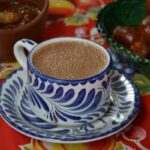
Mexican Hot Chocolate
- Total Time: 8 minutes
- Yield: 1 cup 1x
Description
Everyday recipe for Mexican hot chocolate.
Tools: small pot, whisk or molinillo, small sieve
Ingredients
1 cup (250ml) of whole milk or water
15 to 20 grams of unrefined 100% chocolate
15 to 20 grams (1 to 2 tablespoons) of sugar
5 grams ceylon cinnamon powder or 1/4 ceylon cinnamon sticks
Instructions
- Boil milk or water with cinnamon powder or stick
- Remove from heat and add the chocolate and sugar
- Whisk until it is all blended
- Pour through sieve into cup
- Prep Time: 5 minutes
- Cook Time: 3 minutes
- Category: drinks
- Method: boil and whisk
